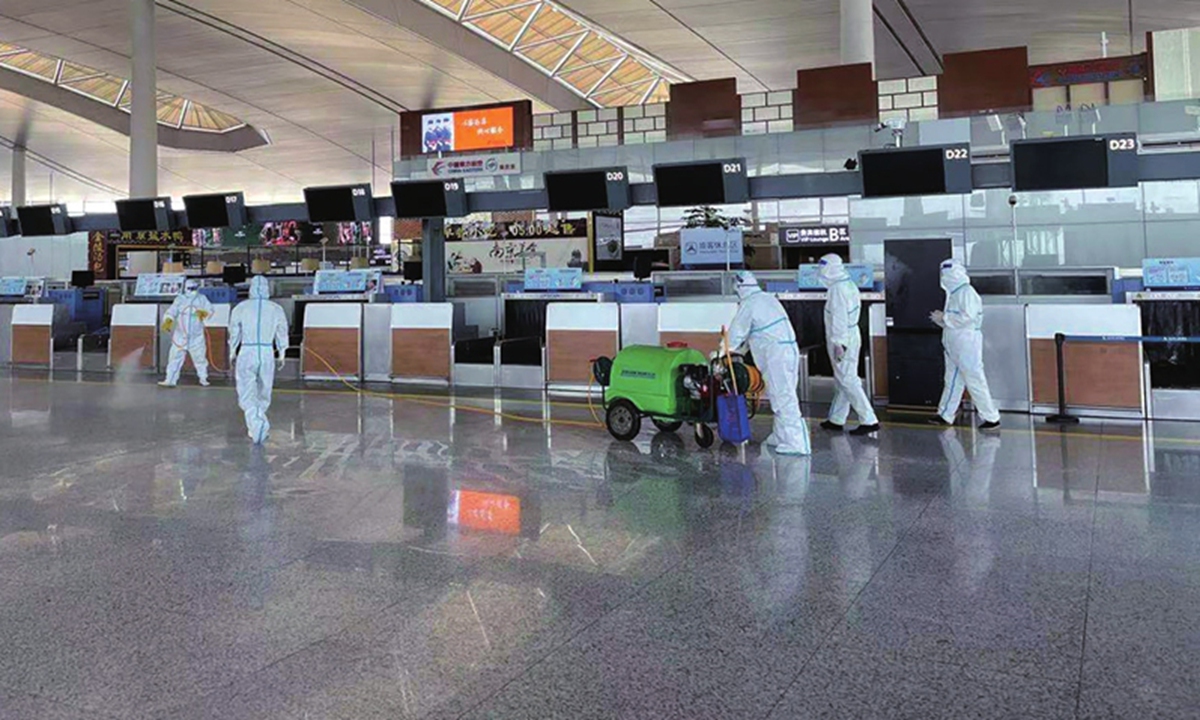Gateways to China enhance ‘firewalls’ against Delta variant, cold-chain transmission remains in focus
Gateways to China to remain cautious; possibilities of cold-chain transmission ‘can’t be ruled out’

Staff members carry out sterilization work at the Terminal 2 of Nanjing Lukou International Airport in Nanjing, East China’s Jiangsu Province on Wednesday after 17 airport workers tested positive for the COVID-19. Photo: Xinhua
As authorities in Nanjing said Tuesday that 44 percent of the confirmed COVID-19 cases in the city can be connected to staff at the Lukou international airport, the worst outbreak in China since that in Wuhan in 2020, the spotlight is again focused on Chinese ports and airports that have been at the frontline in battling imported infections since China cleaned up massive domestic infections last year.
The cases at Nanjing airport involved cleaners and ground crew, while separately one new case was reported on Tuesday linked to the Shanghai Pudong International Airport. Nanjing had recorded 220 local cases as of Tuesday, with almost 100 being connected to the airport.
After an initial epidemiological investigation on the outbreak in Nanjing – capital city of East China’s Jiangsu Province – showed that the first cluster outbreak at the city’s airport was caused when cabin cleaning crew were infected after coming into contact with imported cases. Investigations showed gaps in epidemic control and management at the airport, including lack of timely quarantine measures, substandard cleaning procedures that led to cross-infections and mixing of domestic and international cargo handling. This has led to more questions about how to protect those battlefields from the rampage of the mutated variant.
Since the second half of 2020 when more evidence suggested that imported cargo and international arrivals posed growing challenges to China’s hard-won results in fighting the COVID-19 epidemic, Chinese authorities had put in place strict prevention measures in guarding against imported cases and stepped up efforts to improve anti-epidemic work in vulnerable places like land and sea ports as well as airports. Orders were issued to ensure full-scale disinfection of cold-chain products, strictly separate domestic and international flight handling, and properly manage staff.
Authorities in cities including Beijing, North China’s Tianjin, Guangzhou, capital of South China’s Guangdong Province and Ruili in Southwest China’s Yunnan Province, which are major ports of entry or close to land borders, have been mobilized in recent days to escalate epidemic prevention and control following the outbreak in Nanjing. This includes enhanced nucleic acid testing, properly handling waste from airlines and regulating cleaning work. More importantly, local officials and staff in these places have been urged to remain vigilant given that the pandemic amid the Delta variant spread is still worrisome globally.
Besides plugging management loopholes, some senior epidemiologists highlighted the possibilities of cold-chain transmission leading to the outbreak in Nanjing, a main cause of previous domestic infections in China since the outbreak in Wuhan.
Loopholes to be plugged
The outbreak at Nanjing Lukou International Airport was caused by lax management, a lack of understanding about the severity, complexity and long-term nature of epidemic prevention and control work and the failure to implement epidemic prevention policies, Han Guangzu, an official from the Civil Aviation Administration of China, told a press conference on Tuesday.
The aviation regulator vowed to take much stricter prevention measures on the ground by detailing management measures on the frontline staff, conducting more frequent nucleic acid testing among all-level aviation services staff, for example, front-line staff dealing with imported goods and aircraft-related services are to have nucleic acid tests every other day; adjusting arrival quarantine and health-monitoring policies and enhancing staff protection in line with different work, Han said.
China has done pretty well in containing the virus spread given its past experience, in particular with people management when it comes to the anti-epidemic measures. However, there has been a lack of strict surveillance and testing on cargo and objects, which led to the failure to control outbreaks at places like airports and designated treatment hospitals, Yang Zhanqiu, deputy director of the pathogen biology department at Wuhan University, told the Global Times on Monday.
“For example, the latest outbreaks show that local authorities failed to properly handle the feces of coronavirus-infected patients or trash left by the airplanes where confirmed cases have boarded, reflecting significant loopholes in handling the objects in those places,” he said.
Other loopholes such as inappropriate staff and cargo management also had sounded a warning to other ports and airports.
A government source in Ruili, a border city between China and Myanmar, told the Global Times on Tuesday that since the latest outbreak in Ruili in early July has not vanished, the anti-epidemic mission for Ruili is unprecedented, not only to prevent the domestic infections but also the imported cases.
Departments in Ruili are required to remain alert and avoid any sluggishness in port management. To prevent epidemic resurgence, goods going in and out of China are subject to strict disinfection and nucleic acid testing. All officials in public posts in Ruili have been assigned their own areas of responsibility for border guarding and regular border patrols, the official said.
Ruili is accelerating the establishment of a multi-dimensional border prevention and control system and comprehensively modernizing governance in border areas by controlling factors related to people, villages, passages, certificates and border lines, media reports said.
In early July, some pictures and videos of iron-wire fences in border cities in Yunnan went viral online with some netizens praised them as “firewalls built over one night to prevent imported cases from spreading.”
In Beijing, Party chief Cai Qi urged in a meeting on Thursday that the airport has to increase the frequency of nucleic acid testing and regulate disinfection and airport and warehouse cleaning. Strict personal protection measures shall be implemented for foreign aviation ground service personnel, and cross-operation is not allowed.
Zhang Yuexin, a medical expert specializing in anti-epidemic prevention and control, told the Global Times on Tuesday that the recent stepped-up efforts in epidemic prevention and control across the country is a process of gradually optimizing China’s anti-epidemic polices and measures in face of the threats posed by the Delta variant.
China has continually drawn lessons from previous outbreaks, Zhang said. He noted that the loopholes esposed by the resurgence in the epidemic in Nanjing this time highlights the importance of ensuring people or goods, which are in relation to imported cases, undergo closed-loop management, and the necessity for frontline workers to always keep guard against the virus from overseas.
Possible cold-chain transmission?
The first infections among cleaning crew at Nanjing Lukou airport came after cleaning an Air China flight from Russia on July 10, but the person tested positive only on July 20.
Speaking about the outbreak in Nanjing, Zhang Boli, a top medical adviser who advised in the fight against the outbreak in Wuhan, Central China’s Hubei, in 2020, was quoted as saying in media reports on July 26 that as domestic infections were caused by imported cases previously, the origins-tracing work of the current outbreak was still ongoing. But given the Nanjing airport is an international one, it is highly possible that the outbreak was triggered by cold-chain products or relevant staff.
Over the past week, several cities in Jiangsu launched mass testing on cold-chain products, screening out hundreds of problematic enterprises while the hypothesis that the cold-chain imports may have flared up the epidemic has already become a major focus of Chinese epidemiologists when they studied the early outbreaks in China including the one in Wuhan in a retrospective way.
The Chinese leader of the WHO mission to track the virus origins revealed in March that experts on tracing the novel coronavirus origins should continue to search for possible early cases of the outbreak more widely around the world and further understand what role cold chain logistics and frozen products played in virus transmission.
“Cold-chain transmission via cargo flights still exists,” Yang said, echoing some calls that the hypothesis of the transmission is still worth being studied with continuous attention.


